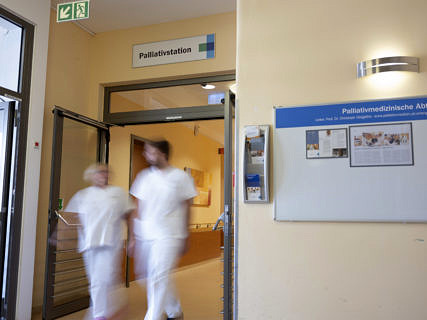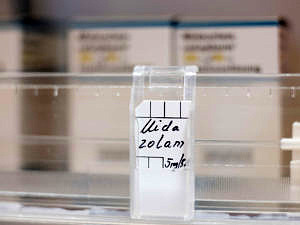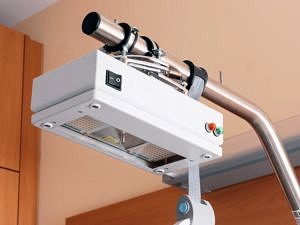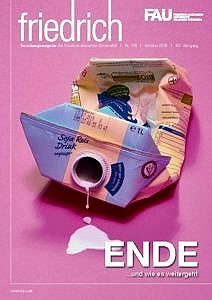When life comes to an end

Doctors specialising in palliative care faced by legal dilemmas
Death is an unavoidable aspect of research into life. Those involved in palliative care at FAU try to find ways of helping those nearing the end of their lives live their last months, weeks and days free from fear and pain. In doing so, they come up against legal constraints.
by Matthias Münch, translated by the FAU Language Service
Choosing to become a doctor is more than a profession, it is a calling. A doctor hopes to diagnose diseases, relieve suffering and, first and foremost, cure patients. Sometimes, however, a cure is not possible – for example if cancer is already too far advanced, or the somatic nervous system has been damaged to such an extent that the patient can barely breathe without assistance. Even if doctors are not in a position to cure the patient, however, this does not mean that they are unable to help – far from it.
Prof. Dr. Christoph Ostgathe cares for people who are terminally ill. He is a specialist in anaesthesiology, palliative medicine and special pain therapy, and is the head of the Department of Palliative Medicine at Universitätsklinikum Erlangen. ‘Our task is to make the time left for the patients as pleasant as possible,’ he says. ‘Anyone who comes to us should, as far as possible, not have to suffer, and should be able to feel free from fear and anxiety.’ Palliative medicine at Erlangen focuses on the personal touch, restricting the use of technology as far as possible. The ward on the second floor of the Department of Obstetrics and Gynaecology doesn’t feel like a typical hospital. The corridors and rooms are painted in warm shades of terracotta, the single and double rooms are a generous size, there is a kitchen, a large patio where beds can be wheeled out, and areas specially designed for patients seeking some peace and quiet. A focus on the personal touch also means that there are specially trained nursing staff, doctors, psychologists, counsellors, art and music therapists, social workers and physiotherapists who are devoted to caring not only for the twelve patients but also their relatives.
Palliative sedation – inducing an early death?

Medical treatments are of course also offered on a palliative ward, especially those aimed at avoiding or at least relieving suffering. ‘Nowadays we have excellent medicines which are both very well tolerated and highly effective,’ Christoph Ostgathe says. ‘However, they are simply not enough for approximately five to ten percent of all patients, whose pain is just too severe.’ In difficult cases such as these, the only way to help is to use medication to reduce the consciousness of the affected patients. Palliative sedation such as this is usually given over a 24 hour period, after which the patient is woken again. Some feel better afterwards and can go without further sedation for a while. For a few, however, their suffering is so great and their condition so critical that they are placed under continuous deep sedation. In consultation with the patient and their relatives, the patient is placed into an induced coma and does not regain consciousness, remaining under sedation until death. Whilst this step avoids unbearable pain for the patient, it raises several ethical and legal issues.
These are the issues being explored by the ‘SedPall’ project, which was launched a year ago. On behalf of the Federal Ministry of Education and Research (BMBF), Christoph Ostgathe is researching current sedation practices in 17 palliative medicine centres predominantly located in South Germany. ‘Although the topic, including continuous sedation until death, has been under discussion for more than 20 years, we still do not have any binding standards or recommendations on how to act,’ he says. ‘There are no reliable data on clinical aspects of sedation as practised in Germany.’ In order to remedy this situation, the team of specialists in palliative medicine from Erlangen will collect data and carry out interviews with doctors, nursing staff and relatives, working together with the Department of Palliative Medicine at LMU in Munich. Ostgathe says, ‘BMBF explicitly asked me to involve patients, relatives and the public in our discussions. The question of when suffering becomes unbearable is not purely a medical question, it is also an ethical issue.’ For this reason, medical staff from Erlangen are collaborating closely with specialists in medical ethics, for example from Universität Halle-Wittenberg.
However, those working in palliative medicine also require a secure legal framework for their work. Prof. Dr. Christian Jäger, Chair of Criminal Law, Criminal Procedural Law, Corporate Criminal Law and Medical Criminal Law at FAU, is involved in the SedPall project, investigating whether continuous deep sedation may by definition actually be equivalent to homicide. ‘That may at first sound absurd, but the German Criminal Code includes paragraphs 216 and 217 which state that actively killing a victim on request or assisting in a suicide is punished with up to five or three years imprisonment respectively,’ explains Jäger. The problem is that rendering a patient unconscious using palliative sedation can lead to a shortened life, for example as the patient is unable to eat and drink while in a coma. Jäger: ‘It has been assumed for too long that terminal care does not need a legal framework.’ The issue of possibly shortening life is not by any means the only issue in question. The following gives an indication of just some of the other aspects which have to be taken into consideration: Does the doctor’s assessment of patient’s health have to correspond to the patient’s perception? Is a person who is suffering agonising pain in a position, from a legal point of view, to give their consent for palliative sedation? Is the decision taken together with the doctor final? And does the fact that the drugs taken by the patient during sedation render them incapable of moving independently make the administering doctor not only guilty of killing on request but also of unlawful detention? ‘It is high time that palliative medicine leaves the legal grey area,’ says Christian Jäger.
Radar on the ceiling in the patient’s room

The ‘Guardian’ project, funded by the BMBF within the context of the research programme ‘Bringing technology to the people’, shows how technical innovation from the University can provide support in caring for the seriously ill. Engineers from the Institute of Electronics Engineering (LTE) at FAU have developed a radar system which can automatically monitor patients’ vital functions, for example breathing rate and heartbeat. The device works with a six-port continuous wave radar system and is able to measure patients’ movements from a distance of several metres, even through clothing or bedsheets. The technicians use a method reminiscent of that used to check for speeding in traffic: a radar wave is directed at the surface of an object and is bounced back. If the object moves, the phase of the reflecting wave changes. This can be used to calculate the strength and frequency of the movement, for example the rising and falling of the patient’s chest. ‘We can, for example, hang our radar on the ceiling in the patient’s room and record movements of even just a few micrometres,’ explains Fabian Lurz, who leads the project at LTE. ‘It can even be used to detect a patient’s heartbeat and automatically recognise any possible anomalies.’ The first phase of the Guardian project has been completed successfully: 30 healthy test persons were monitored for an hour whilst lying down. The results were impressive: compared with established standard methods, such as electrocardiography, the radar system obtained accuracy of 94 percent. ‘Although our method is revolutionary, the technology we use is not particularly complex, which should mean that the costs for the health system are kept within a reasonable limit,’ explains Fabian Lurz. ‘We are very optimistic that the radar system will be able to be launched for general use in the not too distant future.’
Originally, the system had been developed at LTE for automatically monitoring major equipment, for example to trace vibrations which may indicate a technical fault. When tested in practice, however, the radar did not only record the movements of the machine, it also recorded periodic curves for which there at first appeared to be no explanation, until it became clear that what it was recording was the researchers’ heartbeat. ‘A lucky strike for palliative medicine,’ says Christoph Ostgathe. The radar system could be used in future for touch-free monitoring of patients’ vital functions, recording and archiving the data around the clock. ‘Conventional monitoring methods used at present restrict patients’ mobility, and the various cables make the technical equipment on our wards more obvious than we would like.’ The radar, on the other hand, is able to give accurate, objective data concerning the patient’s health whilst hanging unobtrusively from the ceiling. Ostgathe: ’30 to 40 percent of our patients are unable to give any information on how they are feeling. The radar, however, can give us an indication based on their heartbeat of whether they feel comfortable or are rather unsettled.’ Another major advantage of radar monitoring which applies particularly to a palliative ward is that if a patient takes a turn for the worse, relatives can be given enough notice to come and spend the last remaining hours together at the patient’s bedside. The device notices immediately if a patient dies, and the nursing staff can react quicker than before. Guardian is due to start clinical trials in November.
However, using radar to permanently monitor breathing rate and heartbeat is not without legal pitfalls. The radar records the vital functions of everyone in the room, not just of the patient. What happens, however, if the device raises an alarm after registering that one of the relatives has a heart valve defect? ‘The new data protection regulation has made data protection stricter than ever before,’ says Christian Jäger, whose expertise has been sought not only in the context of SedPall but also for the Guardian project. ‘Visitors may have to be informed about the automatic detection of their vital functions.’ But how? Is it enough for there to be a notice on the door? Do they have to be spoken to about the consequences and possibly have to sign a document signing that they have been informed? How often would this have to be done? Or is it enough to simply delete visitors’ data as quickly as possible? In addition, the question arises as to how the doctor should react if an illness or malfunction is diagnosed in a visitor. Would the doctor be allowed to inform the patient? Would he perhaps even be obliged to? Jäger: ‘During the Guardian project, we will at the end of the day have to weigh up benefits for the patient against protection of visitors.’
friedrich – FAU’s research magazine

This article was originally published in our research magazine friedrich. The current issue deals with all aspects of the topic of ‘End’: which of them are unavoidable? How do people deal with this? What does it mean for individuals? Is what people define as the end really the end? Sometimes things just change or develop and something new is created. Occasionally, the end is not an issue at all, with the human race striving for eternity. Is it possible for us to understand this term at all? Is innovation infinite? And do we live forever – on the Internet?
More articles from the magazine can be found under the keyword ‘friedrich’.